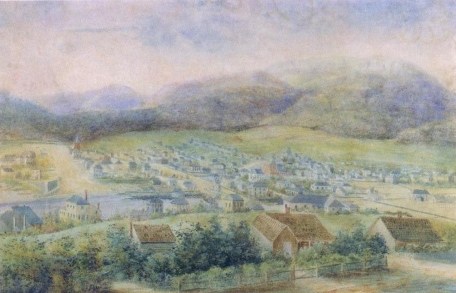Hobart Town
George Augustus Robinson

Details
- Artist
- George Augustus Robinson
- Title
- Hobart Town
- Year
- 1840
- Medium
- watercolour on paper
- Size
- 46.5 x 71 cm
- Details
signed lower right: Hobart 1840 G.A. Robinson
- Stock Number
- 290052
Provenance
Edward Gregg Collection, Tasmania
private collection, Tasmania
Exhibited
''Annual Collectors' Exhibition 1999'', Lauraine Diggins Fine Art, Melbourne, cat. no. 3
''The Painted Vision: 1840 - 1963'', Lauraine Diggins Fine Art, Melbourne, 2009
Literature
''Annual Collectors Exhibition 1999'' (exhibition catalogue), Malakoff Fine Art Press, Melbourne, 1999, p.4
Further Information
George Augustus Robinson, who arrived in Hobart in 1824, is better known as the protector of Tasmanian Aborigines than as an artist. Today he is remembered as the European figure in cap and coat surrounded by a group of native Tasmanians in Benjamin Duterrau's painting ''The Conciliation'' of 1836, in the collection of the Tasmanian Museum and Art Gallery, Hobart. Duterrau also painted several portraits of Robinson.
Robinson's view is taken from a position close to that used by George Evans for his watercolour of Hobart Town, from which the well known aquatint was printed in London in 1828. Another similar view, Vue D'Hobart-Town, Prise de l'Est, lithographed by Koeppelin after the drawing by de Saison, was published in 1830. Both these views depict Hobart at the time they were drawn, hence a few years before the dates they were printed. The state of development of Hobart in Robinson's watercolour also suggests that it may depict the town at a date earlier than the inscribed date of execution. Some similarities in these views may suggest that Robinson was influenced by one or the other. While all three give panoramic views, Robinson's is inclined towards a closer focus on the foreground buildings. Moreover, his watercolour shows a greater stylistic affinity to the work of his friend Benjamin Duterrau, who also painted panoramas of Hobart Town, than to Evans and de Saison.
His own work as an artist took the form of sketches illustrating his field journals, now in the Mitchell Llibrary of the State Library of New South Wales. This view of Hobart Town therefore is a rare example of a large and finished watercolour by Robinson. Whether of his own inspiration or influenced by others, its interest lies both in its rarity and as a visual historical record of Hobart in its early days, presented in the topographical style of the time.
As in Evans' aquatint, and more so in de Saison's lithgraph, the view looks up Macquarie Street showing such identifiable buildings as the Commissariats Store, Bostock's Store, and St David's Church. The attention Robinson paid to the lesser buildings and houses in the foreground possibly can be explained by his earlier career as a builder and a certain pride in recording buildings well made.
David Thomas
